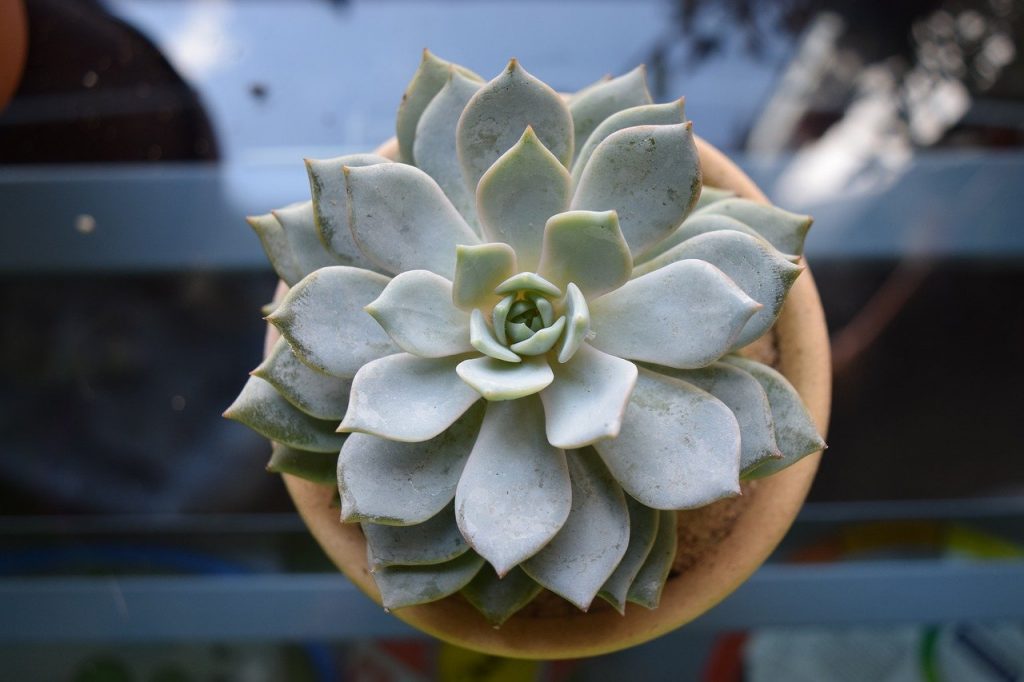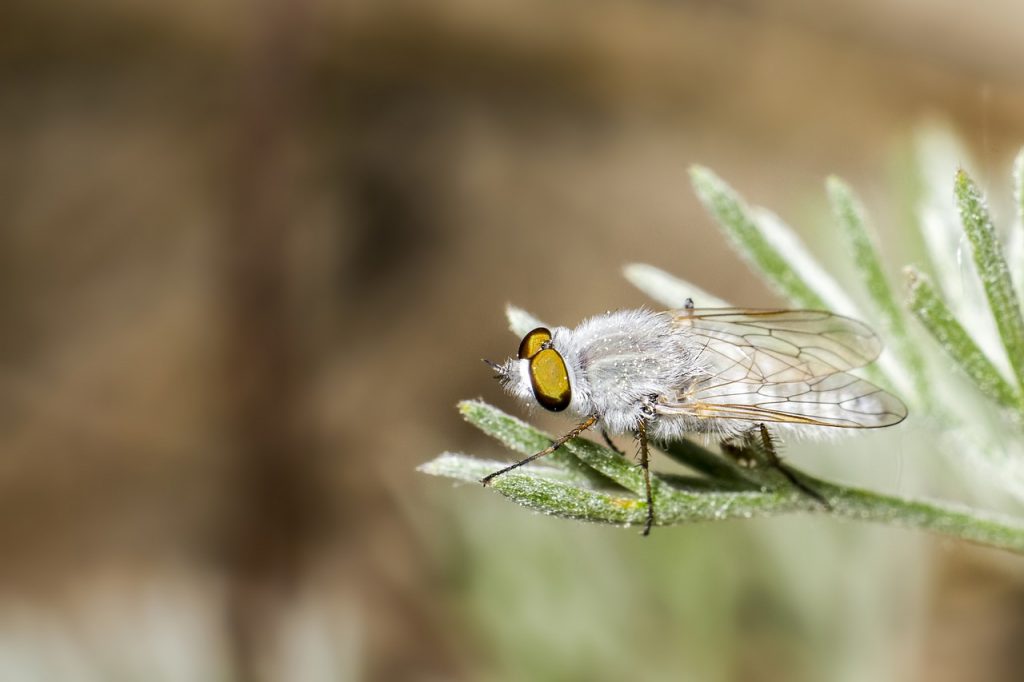The white stuff you can find on succulents, and also in other plants, can come in different shapes and consistencies. Some plants have waxy stuff on their leaves but some have powdery stuff. If you pay close attention to such details, can easily determine what’s going on with your plant. Before we look into details, please note that white stuff can be something completely normal, but it can indicate an infestation or something else that requires your attention. Let’s have a look at 4 most common causes of this phenomenon.
Table of Contents
1. Epicuticular Wax
You may notice some of your succulents that were once vibrant getting pale, soft, and pastel in color. This is due to the development of epicuticular wax. Some refer to it as Farina―a very even dusting of powder. It is a thin layer of silvery film that you commonly see on grapes, plums, and some other plants.
One way to distinguish if the plant has developed this wax is by examining its uniformity. If you see a very even coating, most probably it is farina. The thickness may vary depending on the plant species but it is always evenly distributed. Farina serves as a protective covering to the plants. Because it is hydrophobic, it makes the water bead up to prevent too much water from entering the plant. It also acts as a surface to adhere to dirt particles so it can be easily washed away by just drops of water.
The air can make the plants dry but the farina covering helps it stay moisturized. It also serves as a sunscreen that reflects harmful UV rays from the sun and prevents the plants from sunburn. It also serves as protection from pathogens, insects and extreme conditions. The surface is quite slippery that it makes it hard for insects to walk upon and to lay eggs on. Having the wax on the plant is normal. In fact, it has a lot of benefits for your plants, so it is not advisable to wipe it off. Once the wax is wiped off, it takes a while to come back, so the plant may be vulnerable during this time period.

2. Powdery Mildew
This is a very similar-looking fungal disease that may occur in your plants. If you notice a white, powdery mold on one of the leaves of your plants, it may be a sign of powdery mildew. It appears to be white commonly but sometimes develop yellowish, brown or black growths.
This type of fungus tends to live in warm, dry places similar to places where succulents thrive. Because of the same environment, it is more common to see succulents infected by this fungus, when compared to any other plant family. Unlike farina, it does not spread on the whole plant evenly. It is also a bit patchier than some thick parts of the farina. It appears to be fury or fuzzy and it tends to spread from one leaf to another. Often it only covers one or two whole leaves before spreading to other leaves and nearby plants. It tends to be found in some of your plants’ stems and fleshy leaves.
This fungal disease may not show any harm to your plant and may allow it to live for quite a while until it becomes worse. If not treated, it may take away the nutrients from the plants causing it to become pale green or yellow then later makes it wither. Your plant may lose leaves, fail to flower, or worse, die. Powdery mildew is highly contagious so you may want to separate your infected plants from the healthy ones to prevent further damage. Though it sounds a bit terrifying it only requires very simple and easy treatment.
When fungi occur, you may want to gently pull off infected leaves and separate the plant from healthy ones to prevent the spread. You may also use fungicide (check my favorite fungicide on Amazon, one that works great against powdery mildew in my experience)after the separation to kill the fungi and stop it from spreading throughout.
3. White Flies
White flies are small, white, flying insects that are commonly found in leafy succulents. They reproduce rapidly so you might want to take action immediately when you notice these insects in your plant. The insects and its larva are white but the eggs appear to be yellowish and turn brown when about to hatch.
Unlike farina, they do not produce evenly distributed powdery substance. These insects leach nutrients from the plant leaving honeydew that causes dark mold. If you notice this sticky substance on your plant, it is most probably an indication of white fly infestation. You may also notice these insects flying underneath the leaves when the plant is shaken. Most often, these are found under the leaves rather than on top. They thrive in hard to reach places. These insects cause the plants to deform and eventually wither when not treated.
Since these insects multiply rapidly, it may be a bit hard to remove them totally. You may try blasting out the insects and larva with water. Spraying the plant directly on the infected parts with a diluted rubbing alcohol may also help. Using formulated dish-washing soap in a spray may also be effective. You may want to repeat this as necessary until all of the insects fall out and die. Worm castings may also be effective. Worm castings are mineral-rich worm dung that can be beneficial to the plant. It may serve as an organic fertilizer while protecting your plant from infestation. This type of manure enables the production of chitinase― a hydrolytic enzyme that breaks down the exoskeleton of insects. The white flies will detect this enzyme and decide not to lay eggs in the plant knowing that it may be harmful to it.

Mealy Bugs
During winter and cold weather, bugs and pests tend to hatch out and find something to eat. This is most likely the time when mealybugs try to thrive in plants like succulents. At first, you might not notice the bugs. You might notice some of the leaves deforming and white spots occurring on the leaves of your plants before actually seeing the bugs.
So, when this occurs you might want to scan the whole plant because they might be hiding somewhere underneath the leaves or in the middle part of your plant. Commonly, the white spots look like cottony substance that resides at the bottom of the leaves or on the stems. Mealybugs are one of the most common infestations in plants like cacti and succulents. These are tiny elliptical insects that are usually 2-3-millimeter-long and commonly are white, gray, or light brown in color.
Similar to the white flies, it also produces honeydew that supplements further bacterial and fungal infection. These bugs can also be spread from plant to plant, hence you may want to isolate the infected plant from the healthy ones just like how you deal with white flies. You may use diluted rubbing alcohol with a 70% solution or you may also use insecticide, such as this great one from Amazon (* affiliate link, I may earn a small commission at no extra cost to you if you decide to make a purchase).
You can get rid of the white, cottony substance by dipping a q-tip in the solution and rubbing it off. Some plants may be too small for the q-tip to fit so spraying the plant directly on the infected areas may also help. These bugs are hard to get rid of and may require a couple of repetitions every week. They do not disappear easily and sometimes are found on the roots of the plant. When this happens you may have to remove the plant from the pot and clean of the soil.
One study also showed that ladybugs as predators for the mealy. Ladybugs are not harmful to succulents and they are very pleasing to the eyes. They may help by eating every aphid, mites, and mealy that they find.
* May also interest you: Aphids on Succulents: Best Homemade Solutions
Final word
Pests in succulents may be hard to deal with sometimes, but with the right amount of knowledge, and some perseverance, you should be able to take of the problem. White stuff may appear in some of your plants but make sure to scan the plant first and examine it properly before doing anything. In many cases the white stuff actually serves as a protection to the plants, like farina, but it can be also harmful to your beloved succulents, when it happens to be powdery mildew, white flies, or the dreaded mealybugs.
On the top of the most common explanations there may also be another reason, so if you are not sure I suggest you to take a photo of the white stuff that you noticed on your plant, and directly consult a specialists, an experienced gardeners, or people with experience from the same area (since the thing may be specific for your geographical region or climate). I hope it helps, and wish you best of luck with your succulents!
P. S. Don’t forget to check my complete guide on succulent growing, to grow your plants like a pro!
